
Tuesday November 25, 2003
The Fly GT-40
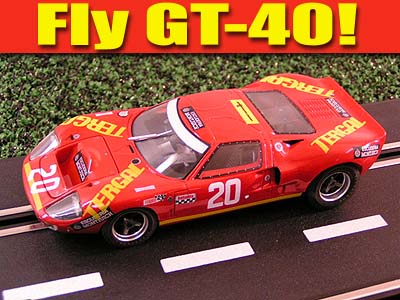 Has there been a model in our hobby that has been talked
about more than this release? For years the prototype photos and drawings have
been circulating on the web as well as in Fly's own catalog, yet the model was
continually delayed making many wonder if this classic would ever materialize.
Has there been a model in our hobby that has been talked
about more than this release? For years the prototype photos and drawings have
been circulating on the web as well as in Fly's own catalog, yet the model was
continually delayed making many wonder if this classic would ever materialize.
Well not only did it finally arrive, but Fly has decided to bring us 2 versions! The reason for this is that the initial release did have some issues with it regarding it's running capability, or lack thereof. With all the attention we sometimes to give to scale accuracy, sometimes we forget this IS a slot car and its purpose (for most of us) is to be raced. This is where Fly has been lacking the REAL attention to detail they have needed in some cases. Well soon after the initial release of the Gulf version this revised chassis arrived to help correct some of the problems.
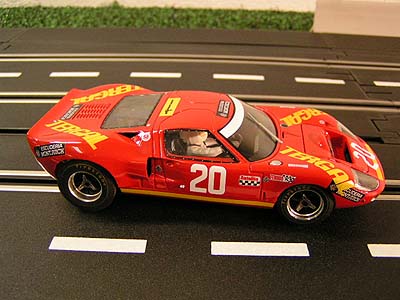
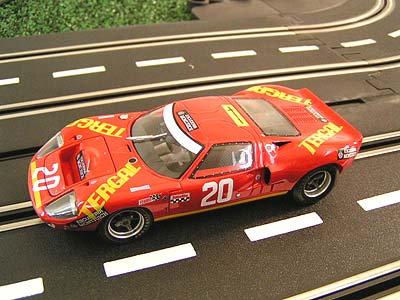
Hopefully the photos tell you how close Fly has come in capturing this model in our scale. I have to admit that once again Fly has created a stunner in the looks department. And although this model is a sample of future releases, Fly really did a fine job in the overall fit and finish of the body and paint work. There were some mold line and slight flashing issues, but nothing too serious and should not offend most of you out there.
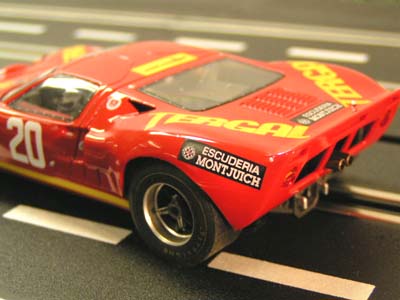
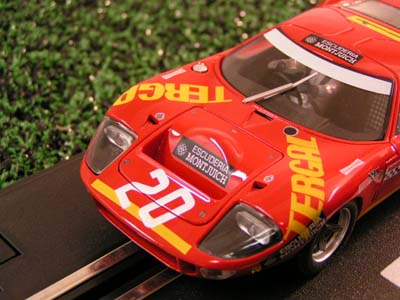
Tampo-stampings are very well done with only slight fading in smaller areas. However, it seems we are still plagued with the one issue that I cannot understand we still have: The markings are applied AFTER the clear-coat leaving them unprotected from the effects of hard racing. If there is a clear-coat over these markings, it is extremely light. I know Fly has had some issues in this regard before such a several releases of the Capri, and it seems to be still with us.
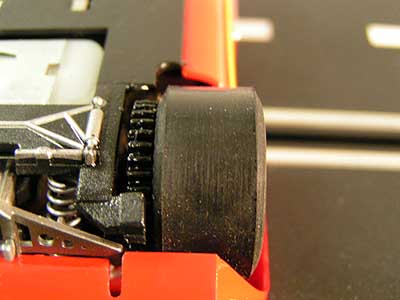
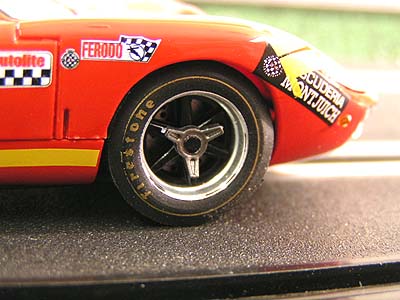
One of the bright spots for myself were the rear tires Fly has chosen to equip it with. These rear tires are of a medium to soft compound and provide excellent grip...that is when they are sanded, trued and clean. The wheels have plenty of detail using inserts as you can see in the photos. Small details like this do catch the eye and add a great deal to the model. I did notice some excess flash molding on the 3 prong knock-offs, but this is easily trimmed away if it bothers you.
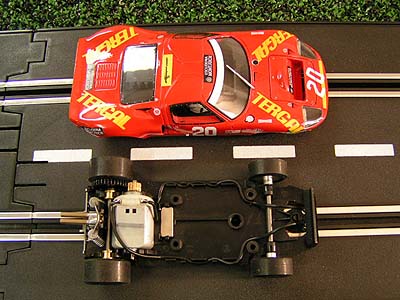
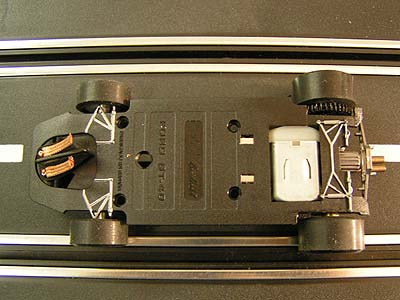
Let us now get on to the new chassis. Underneath you will some differences in both the front and rear of the model. My only issue here is the front still has problems and most of it is caused from the detailing Fly has molded into the underside. Although I am happy that we have a solid front axle instead of the older style stub axles, if there ever was a time where extra (and hidden mind you) detail interferes with performance it is here. Although this chassis has shortened the "steering and suspension" from the original, it still rubs the inside of the tire. Thankfully, it is easily cured by simply cutting these away I highly suggest you do the same for the best performance.
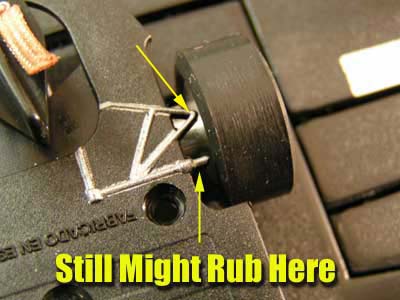
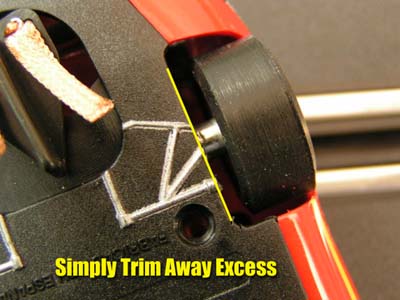
Inside we see a different design layout for the Mabuchi motor sitting in the sidewinder configuration. Equipped with a 11 tooth pinion driving a 36 tooth spur gear that is now moved flush with the rear wheel reminiscent of older Fly Classic designs. The small changes made in the rear of the chassis has allowed at least the rear wheels to turn freely with no rubbing on either the body or the chassis. The rear axle once again rests inside brass bushings snapped into the chassis...and once again I advise that you add a slight amount of adhesive over the tops of these bushings to keep them seated.
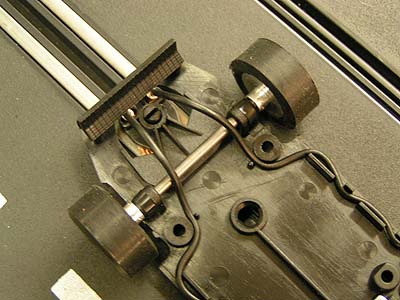
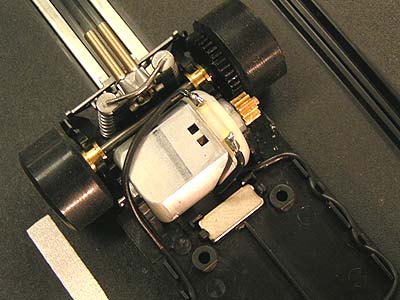
The familiar Fly bar magnet is in place for those who use it, but the interior leaves little room for tuning otherwise. Self-adhesive sheet lead place under the chassis would most likely be a good option to tune without magnets. You might find that the magnet can pop loose in a harder crash, so once more you might want to add some adhesive here to keep it secure. Gear mesh isn't as quiet as you might be used to with other models out of the box, yet my sample was not that bad and after some break-in it decided to smoothen out just fine.
In fact this car is slowly becoming one of the smoothest Fly models I own, and the more I drive it...the better I like it. Performance of this model actually ended up being another bright spot. After truing the tires and removing the front steering and suspension moldings, we began to get some laps under our belt rather quickly. Lap times were surprisingly faster than I expected with averages of 5.2 seconds. Braking and acceleration were both crisp and you should enjoy the handling it provides. Even though it has the standard bar magnet in place, you can still swing the rear end out more than you might expect and have decent time for recovery.
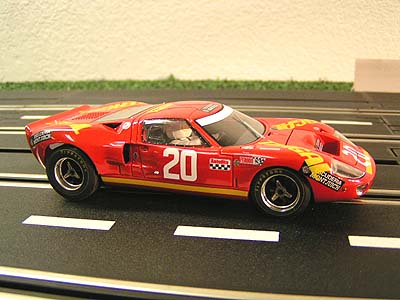 Although this chassis does improve things, I still feel
it is better suited to the more advanced enthusiast who is willing to perform the
necessary modifications. Fly has put forth a nice effort in scale accuracy, and
the fact that they have changed the original chassis shows at least some level
of commitment to the slot car racer. GT-40 fans will of course still want this
release and if Fly sticks with current practices we can count on multiple
liveries over time.
Although this chassis does improve things, I still feel
it is better suited to the more advanced enthusiast who is willing to perform the
necessary modifications. Fly has put forth a nice effort in scale accuracy, and
the fact that they have changed the original chassis shows at least some level
of commitment to the slot car racer. GT-40 fans will of course still want this
release and if Fly sticks with current practices we can count on multiple
liveries over time.
- Harry
As always feel free to contact me about this article or just the hobby in general at harry@homeracingworld.com, or better yet drop into our Message Forum and share your thoughts with other enthusiasts!
Thanks go to Scalextric-USA for providing us with this model.